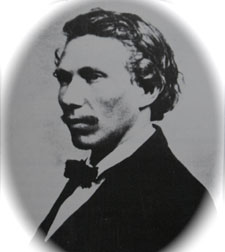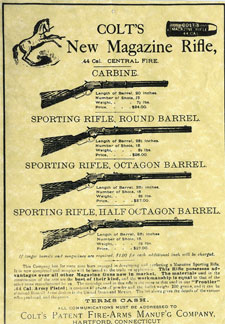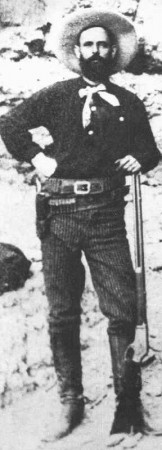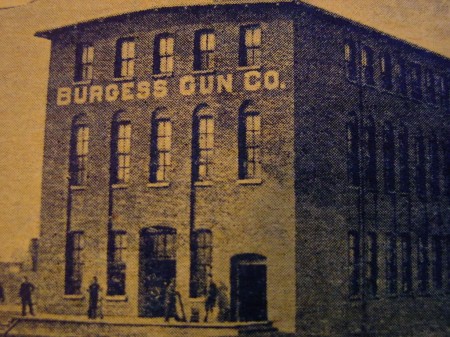by Robert White
 With 894 patents, Andrew Burgess is one of the most prolific firearm inventors the world has ever known (second only to John Browning in number of firearms patents issued to an American), and a man of varied talents beyond firearms design.
With 894 patents, Andrew Burgess is one of the most prolific firearm inventors the world has ever known (second only to John Browning in number of firearms patents issued to an American), and a man of varied talents beyond firearms design.
Burgess was born January 16, 1837 in Dresden, NY to John Christian Burgess and Achsah Christie (Davis) Burgess, and was the grandson of a a Hessian deserter from the American Revolution. He was a skilled photographer whose family-owned farm bordered the homestead of Civil War photographer Mathew Brady. Burgess ended up apprenticed to Brady and photographically documented Reconstruction in the post-Civil War South, as well as documenting the execution of the French-installed Emperor Ferdinand Maximilian in Mexico. Andrew Burgess is now credited to have taken the famous “Brady’s Lincoln” photograph that is found on the American five dollar bill.
Later, Burgess photographed the Franco-Prussian War (1870-1871) before returning to the United States in 1871. It is speculated that during his stint as a photographer during the Franco-Prussian War he developed an interest in firearm design. His first patent was granted Sept. 19, 1871, for converting the Peabody and Werndl arms to magazine rifles.
When Brady fell on hard times in 1874, Burgess purchased the studio, but sold it back by 1876. Some of the photos credited to him:
Edwin McMaster Stanton, secretary of war
William Pitt Fessenden, secretary of the treasury
General Winfield Scott Hancock

During the 19th century Colt was known for their revolvers and Winchester was known for their lever action rifles. However in 1883 an improved model of lever action rifle was presented to Colt by Andrew Burgess. Burgess had created a lever action rifle similar to the Winchester Model 1873 but had several improvements that made it more accurate, reliable and tougher.
Winchester was not happy about having competition from Colt. Shortly after production began representatives from Winchester met with representatives from Colt. From there the Winchester reps presented a number of pistol prototypes (Mason revolvers) they intended to manufacture. An agreement was made that if Colt stayed out of rifles Winchester would stay out of pistols. Production of the Colt-Burgess Rifle ended after only 16 months of production. When production ceased the total output of Colt-Burgess rifles and carbines was a mere 6,403 units, all in .44-40 caliber, with some 340 of these being shipped to the London agency.

Andrew Burgess partnered with Eli Whitney with his design for a lever action repeating magazine rifle chambered in the .45-70 Government cartridge. It was hoped that this gun would be accepted in the military trials of 1878 to adopt a repeating rifle. Although not successful, Whitney continued production in sporting and military versions.
In 1881, the Marlin Firearms Company introduced the Model 1881 lever-action tubular magazine repeating rifle. The key features patented by Andrew Burgess. This rifle was available in a variety of calibers ranging from .32-40 to 45-70 Government.
Burgess established his own company in 1892. The Burgess Gun Company manufactured slide action shotguns and rifles operated by a unique pistol grip prior to their being purchased by Winchester repeating Arms Company in 1899. Winchester commonly bought out competing firms and then closed them.
One notable firearm resulting from the 100’s and 100’s of patents was the Burgess Folding Gun, designed for police service, express messengers, prisons and banks. It was made from 1892 to 1899. Nearly semi-automatic in operation, the Folding Gun had a sliding pistol grip assembly that moved backward under recoil and could be quickly shoved forward again by the shooter. While able to fire its six shots in less than three seconds, most users appreciated its attribute of compact storage in two hinged-together sections. These two components could be quickly rejoined, allowing the Folding Gun to be carried under a coat in a belt holster and drawn much like an oversized handgun.
While primarily manufactured as a shotgun, a few were also made in rifle calibers. The Burgess Folding Gun was a popular choice for law enforcement agencies seeking a compact arm. One prime reason for ready police acceptance may have been its consistent three-foot pattern with buckshot at 40 yards.
According to Mark Lee Garner in “To Hell on a Fast Horse”, Pat Garrett was armed with a Burgess when he was killed on Feb. 29, 1908.

While he had gained renown as an arms inventor, Burgess was also remembered for his unique style of conducting his research and, during later years, would frequently go to St. Augustine, Fla., where he had set up a floating workshop adjacent to a beachside bungalow. When stress onshore became too great, the solitary Burgess would pull up anchor to float away on the currents, playing his favorite violin and periodically firing a
shotgun to ward off seagulls.
His last patent was granted in 1906 and he died from heart failure on December 19, 1908 at the age of 71.
References
The Burgess Long Range Repeating Rifle Model 1878, by Dale A. Olson
Lever Action Magazine Rifles, Derived from the Patents of Andrew Burgess, by Samuel L. Maxwell

Long time ago now, he he.
Generally…
I’ve had only two Burgess rifles in my life. both now long gone. One was a Colt carbine, and it was more like a Model 92 than an 1873. I found the rifle WAY ahead of the ’73 Winchester design. The other was a Whitney/Burgess in .45-70. Long, long action, but again far superior to the ’76 Winchester because of its ability to use the military length cartridge. It was so long that part of the action was hidden by the forearm. As I recall, it used a ratcheting cam to operate the action and was smooth as silk. I could never keep one of the Burgess designs long, because I was young and somebody with a lot more money than I had always came along and paid me a very nice profit, lol.
Burgess deserves to be remembered much more than he is. Thanks for posting this, Ian.
Now the 44-40 Burgess lever-action is produced by Uberti (also in .45 Colt)
Probably not telling anyone anything new here, but…
The 1883 Winchester “Mason” revolver that Ian mentioned was based on the circa 1876 prototypes by none other than Hugo Borchardt, the self-loading pistol pioneer, and S.D. Wood. It used a swing out cylinder 13 years before Colt brought out their own model of 1889*. Mason worked for Colt before leaving in 1882 for Winchester, of course. But before he left, he began working on a new revolver with C.J. Ehbets… which eventually became the Colt 1889.
*And despite what Wikipedia says, the 1889 was not the first swing-out cylinder DA revolver out there. The “Guerriero” was a swing-out pinfire revolver, patented in the early 1860s, by Alexandre Guerriero of Genoa, Italy and later tested by the French Navy.
First American Swing Out Cylinder Revolver, possibly, was Bacon Hopkins, patented for the name J.W.Hopkins in May 27, 1862, It had SA, spur trigger mechanism, and by cause of
infringment to a Smith Wesson patent, ıt was discontinued after production of a few hundred pieces.
Correction; Inventor’s name; Charles W. Hopkins, patent SN; 35419.
Winchester produce also M1877 Wetmore-Wood swing-out revolver:
http://milpas.cc/rifles/ZFiles/United%20States%20Rifles/Winchester/winchester%20models/Experimental%20Models/Non%20Rifles/Wetmore-Wood/M1877.html
for Ottoman Empire, so far I know this is first production (non-prototype) swing-out revolver which enter service of armed forces.
Interesting stuff! By following the paper-trail, (“Winchester Repeating Arms Company” by Herb Houze, on Google Books,) it seems the info about the Turks ordering 30,000 Winchester-Wetmore-Woods came from a letter from the General Manager of Colt works to Baron von Oppen, (their London agent). From the way it was written, it seems to be second-hand info that the Colt man heard from another source, rather than hard fact. Houze says that no Winchester company documents support the Ottoman contract, yet “evidence does exist” that some revolvers were made in New Haven for them and machinery was supplied. Just what this evidence is, he doesn’t elaborate. Herb Glass has it that only 13 prototypes of these Winchester revolvers were made, most of them having swing-out cylinders.
And unfortunately the only website that has any photos of these historically important Turkish revolvers is the one you linked to above. Zhuk has it that the Ottomans actually purchased Russian-model S&Ws converted to rimfire at this time and doesn’t mention the Wetmore-Wood at all, as far as I can tell. Taylerson is also silent on the matter, although as he tends to concentrate on British patents, this perhaps isn’t so surprising.
I’d love to know what happened to the Turkish Wetmore-Wood revolvers, if they ever existed.
“Military Museum” at Harbiye/İstanbul has very rich stuff of small arms of Ottomans
used in a very wide range of history. If it were any specimen of mentioned Wetmore-
Wood revolvers, it would certainly take place over there. But there is not.
Thanks for the info. Looks like the Ottoman contract was just a story, then. It seems that the more you dig into the Winchester revolver, the muddier it all gets.
And forgot to say; good find on the Bacon Hopkins revolver!
It is interesting to speculate what may have been and what we have almost certainly lost through the fate of Italian history.
Italy has lost at least 2 centuries of economic development; through French imperialism and vassalage (including the crushing of the 1848 revolution), the “unification” under the Savoys, then nationalist populism from the charlatan, Agostino Depretis in 1876 to the present, with only temporary respite under Einaudi’s (Ludovico’s grandad) guidence in the immediate post WWii years.
Italian engineering has never been short of inspiration, not only the swing out cylinder revolver, but also the heart of most lever actions, the early heavy machineguns and the early autopistols, the toggle lock was supposed to have been developed by an Italian gunsmith.
A current version of the Burgess Folding Gun would probably make for an excellent survival shotgun ( or rifle, if made as one ).
Is there a chance of reviving the patent to manufacture it in such a configuration today?
Hi Earl,
All that a patent is, is an excuse for a king (or the democrats who claim the powers of a king (and more)), to sell monopolies.
In the case of patents, it isn’t like the East India Company or Virginia Company monopolies, it is for the exclusive rights to an invention for a number of years.
Burgess’ patents (like those of the 1911 and the AR15) have lapsed, so anyone who can pay off the king’s tax farmers (BATFE etc) for long enough and with enough money left to set up production can do so.
Thank you for the insight with regard to this particular situation, Keith. As usual, your astute assessments are always much appreciated.
If the situation is as described, there is hope, yet — the problem being, of course, the ability to pay off the assorted taxes and fees you mentioned sufficiently to establish a viable production schedule, which in turn would be dependent on the market demand for such a product in the eternal cost / profit equation.
Daunting, but not impossible — yet still reliant upon finely-calculated probabilities concerning that pervasive and eternal bugbear, “market timing”.
Interesting story about Burgess folding gun (from: http://www.nramuseum.org/the-museum/the-galleries/the-american-west/case-43-the-stars-sixguns-frontier-justice/burgess-slide-action-folding-gun.aspx)
“In 1895, an armed man is said to have entered Theodore Roosevelt’s office and fired six times before the startled future President could protest. “T.R.” was then President of New York City’s Board of Police Commissioners. The intruder was a zealous gun salesman named Charlie Damon. In spectacular fashion, Damon was demonstrating the advantages of a recently introduced police shotgun made by the Burgess Gun Company. He hoped to see its adoption by the New York City Police Department. Thoughtfully, he had used only blank shells.”
Hi, Daweo :
Thanks very much for the information and additional links — very interesting, and great reading, too! Even though he was taken by surprise, it says a lot about the gun’s rapid rate of fire that even T.R., with his well-honed fighting abilities, was still unable to react in time.
Would you happen to have the address of Burgess Gun Company? I live in Buffalo and I would be intrigued to learn whether the building still stands.
Unfortunately, I have not been able to find the address.
Hi Ian,
If you learn something, please let me know. I’ll be happy to go to the place and take pictures.
Paul
Hi Ian,
The factory was on the corner of Niagara Street and the beltline. The beltline refered to a railroad which no longer exists. Like so much of our heritage here in America, it’s now a parking lot.
Paul
An ‘Anthony Burgess’ appears at the start of paragraph 7. Did Burgess and Browning interact? Give the same time period and both being in the US firearms industry you would think they had to at least know about each other.
Many moons ago I had a beautiful Colt Burgess in .44-40. But, like Dolby I was young and seduced by a big stack of cash at the old Astro Hall gun show. The money is long gone, but I wish I still had that rifle (along with some others I foolishly sold back then). I’ve always wished that Colt and Winchester had never come to their “gentlemen’s agreement,” and more of the Burgess rifles and Mason revolvers had made it into the marketplace. Think of all the interesting stuff we’d have to add to our collections had Colt and Winchester crossed over into each other’s markets back then. Oh well …
Searching in Google patents by inventor “Andrew Burgess” return very interesting results. He patented not only manual operated shoulder firearms, but also automatic pistol and automatic long-guns. See:
https://www.google.com/search?tbo=p&tbm=pts&hl=en&q=ininventor:%22Andrew+Burgess%22
Some notes to patents after flicked:
Burgess patents recoil- and gas-operated firearms.
Early pistols have under-barrel tubular magazine, hence the capacity would be inferior to revolver (unless the very long barrel will be used), late pistols has box magazine in grip, as a vast majority of modern designs.
In 1892 Burgess patented rotary (if I understand correctly 2nd drawings sheet – anyone can confirm?) magazine:
https://www.google.com/patents/US589118?dq=ininventor:%22Andrew+Burgess%22&hl=en&sa=X&ei=k0FGU8TREu2h7Aa6vIDoAQ&ved=0CEUQ6AEwAzgo
Please consider a review of “Weibel M/1932”. Thanks for a great site and youtube channel.
kind Regards
Adam